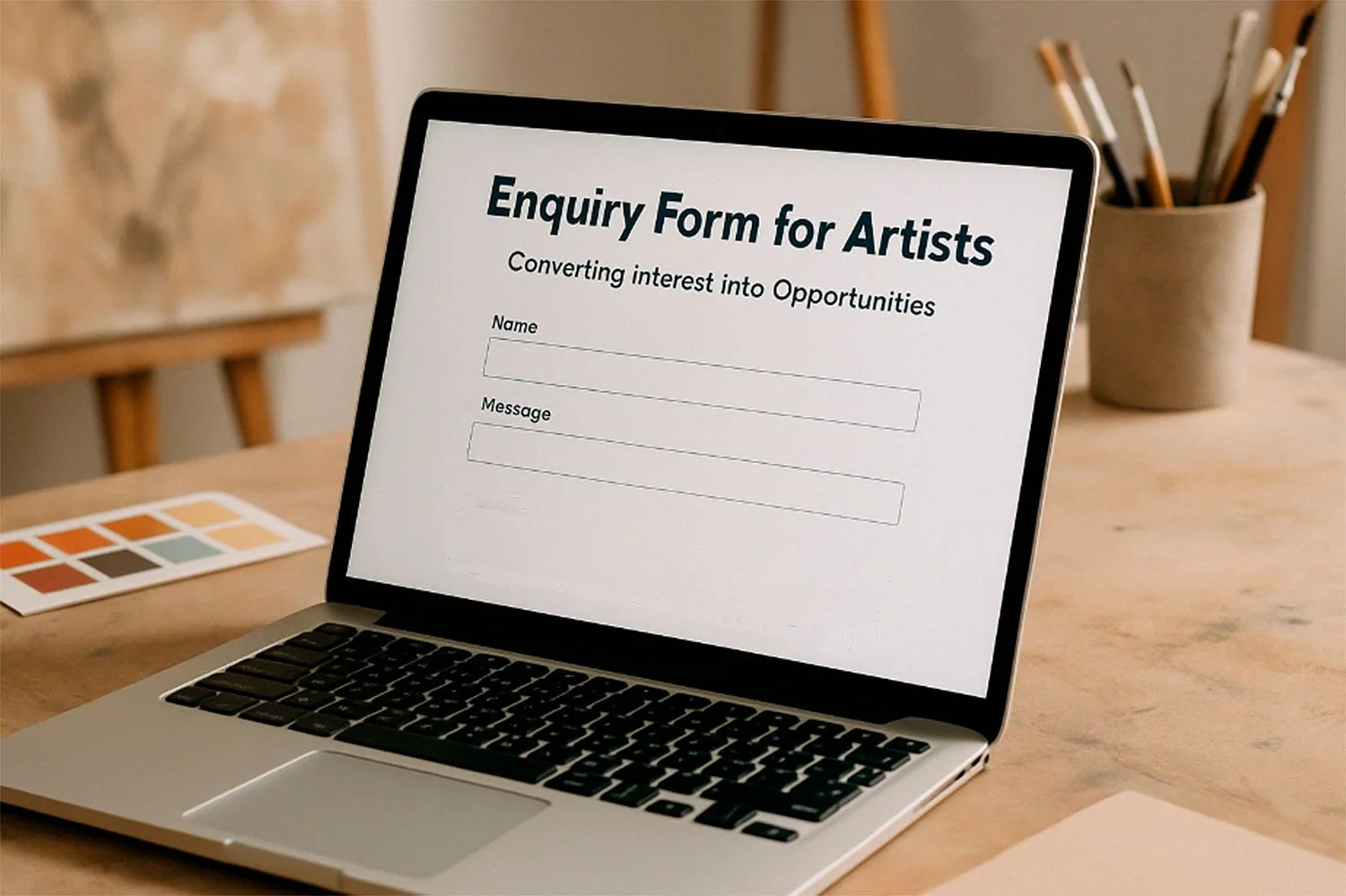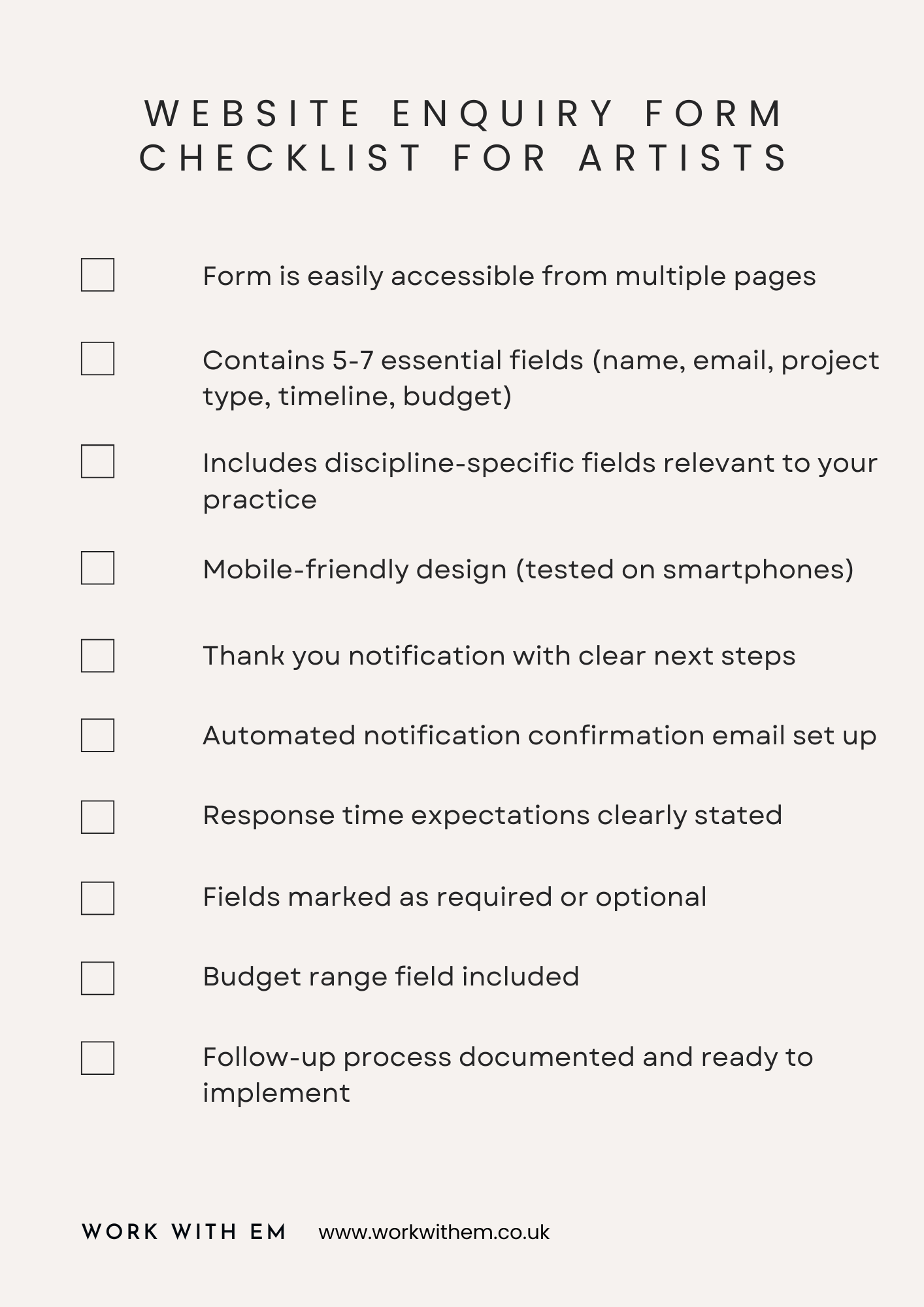Designing Effective Enquiry Forms for Visual Artists: Converting Interest into Opportunities
A Guide for Visual Artists and Makers on How to Create an Enquiry Form That Sparks Meaningful Conversations
Reading Time: 7 Min | Last Updated: April 2025
Image source - Visual concept created with the help of AI and design software
Quick Takeaways (1-Min Skim)
An enquiry form is often the first real point of contact between an artist and a potential client, collector, or collaborator—so it needs to do more than look nice.
3-7 fields is the sweet spot – enough information to qualify leads without causing form abandonment
Always include project timeframe and budget range fields – they help qualify serious enquiries and prepare you for the conversation
Set clear response time expectations – and respect them to build immediate trust
Customise form fields based on your discipline – visual artists, ceramicists, and textile designers, craftspeople depending on your business model and customers all need slightly different approaches
Include a thoughtful automated thank-you confirmation email to reassure potential clients their enquiry was received
The Hidden Power of an Artist’s Enquiry Form
“I submitted an enquiry on your website last week..."
These words from a potential client should fill you with excitement, not dread. Yet for many artists, craftspeople, and creatives, enquiry forms become a barrier to connection—or a source of frustration when they fail to capture the right information. Worse still, some artists skip the form entirely, relying solely on email enquiries to generate leads. ➔ Discover how to convert form submissions into art sales.
However the enquiry arrives, the story is often the same: three emails later—or one long Zoom call—you finally uncover what the potential client really wants… only to realise you can’t deliver it for a range of reasons. It’s been a complete waste of your time, and theirs.
As someone who has designed websites for dozens of artists at various career stages—from early-career makers to established professionals—I’ve seen firsthand how a well-crafted enquiry form can transform casual interest into meaningful opportunities.
Your website enquiry form isn't just an admin tool—it’s the beginning of a conversation with someone who might invest in your work, commission a piece, or open the door to something bigger. Let’s explore how to make yours work beautifully for both you and your future clients.
What Information Should You Ask For?
Essential Fields (Include These)
The perfect enquiry form strikes a balance—gathering enough information to move the conversation forward without overwhelming your website visitor. Below are the essential fields I encourage every visual artist and maker should include if using a form to generate leads:
Name - First name at minimum, full name if you prefer a more formal approach.
Email Address - Your primary contact method. Always make this required.
Project/Interest Type - A dropdown menu with options relevant to your specific art practice:
Commission enquiry
Purchase of existing work
Exhibition opportunity
Press/media enquiry
Stockist/wholesale enquiry
Workshop/teaching enquiry
Other (with a small text field)
Timeline/Deadline - When they need the piece or response. Options might include:
Just browsing/no specific timeline
Within 1 month (urgent)
1-3 months
3-6 months
6+ months
Budget Range - Perhaps the most crucial field for qualifying leads, though it can feel awkward to ask. Present ranges tactfully:
Under £500
£500-£1,000
£1,000-£2,500
£2,500-£5,000
£5,000+
Prefer to discuss
Brief Message - A small text area where visitors can explain their specific interests or questions. This often reveals their communication style and how serious they are.
How They Found You - Valuable marketing data:
Social media (Instagram, Facebook, etc.)
Search engine
Referral from friend/colleague
Exhibition/craft fair
Online marketplace
Other
Key Insight: Studies show that shorter forms consistently lead to higher completion rates. In fact, forms with just three fields often convert best, while adding more than seven fields can start to negatively impact conversions—dropping completion rates by roughly 3% per additional field. If you want more people to fill out your form, prioritise only the information you truly need at this early stage of the conversation.
Image source - Visual created with the help of AI and design software
Discipline-Specific Form Fields
For Visual Artists Handling Pricing Enquiries
If you're a painter, printmaker, sculptor or photographer handling enquiries about existing work, consider adding:
Artwork Reference - "Which piece(s) are you interested in?" (dropdown of current available works or text field)
Delivery Location - Important for calculating shipping costs, especially for international enquiries
Intended Display Environment - Home, office, public space, gift (helps guide conversation about the piece's context)
Framing Preferences - Framed or unframed (if you offer both options)
Tip: If you have many available works, consider including a checkbox that says "I'd like to discuss multiple pieces" rather than forcing visitors to list everything in the message field.For Craftspeople, Ceramicists or Textile Makers Working with Interior Designers
Interior design collaborations require specific information. Consider these additional fields:
Project Type - Residential, commercial, hospitality, etc.
Quantity Required - Essential for production planning
Dimensions/Scale - These constraints are generally crucial for interior projects
Colour Palette/Material Requirements - To assess compatibility with your practice
Project Stage - Concept, development, final specification (helps determine urgency)
Interior Design Tip: For B2B enquiries, include a checkbox for "Are you working to a specific brief?" This helps set expectations about customisation or bespoke possibilities.For Visual Artists Pursuing B2B Project or Brand Collaborations
When working with brands on licensing, product development or installations:
Company/Brand Name - Who they represent
Position/Role - Their decision-making capacity
Project Type - Product collaboration,Public art, installation, licensing, etc.
Rights Requirements - Exclusive or non-exclusive use
Marketing Expectations - Will you be expected to promote through your channels?
Timeline for Decision-Making - How quickly they need a response versus project completion
Setting Clear Expectations After Form Submission
The moment after someone submits your form is crucial. This is when they're actively engaged and wondering, "What happens next?"
Your Thank-You Notification Should Include:
Clear Response Timeline: "Thank you for your enquiry! I respond to all messages within 2 working days."
Next Steps: "Here's what happens next: I'll review your enquiry and email you to arrange a brief conversation about your needs."
Alternative Contact (optional): "If your enquiry is urgent, you can also reach me directly at [email]."
Encourage Connection: "While you wait, feel free to explore more of my work on [Instagram/portfolio link]."
Automated Email Confirmation
Set up an automated Thank-You email that sends immediately after form submission. This should:
Confirm receipt of their enquiry
Reiterate your response timeframe
Include your signature with links to your portfolio and social media
Add a personal touch that reflects your brand
Best Practices From Successful Artist Websites
Keep Forms Visible and Accessible
Don't hide your enquiry form behind multiple clicks. Consider:
A prominent "Contact" or "Enquire" button in your navigation
Contact information in your footer
Contact forms embedded directly on relevant pages (e.g., commission information page)
Use Conditional Logic for More Complex Enquiries
If you offer multiple services or products, use conditional logic to show only relevant fields:
If "Commission enquiry" is selected, show commission-specific questions
If "Purchase existing work" is selected, show inventory-related questions
This keeps forms concise while still gathering necessary information
Add Form Analytics to Understand Behaviour
And if you fancy some techy stuff consider adding form analytics to understand:
Where visitors abandon your form
Which fields cause hesitation (time spent)
Which form variations convert better
Which referral sources lead to completed enquiries
Enquiry Form Examples for Artist Business Model Types
(Tip - adapt if they fit your creative model)
Ceramicist Website
Business form focuses on commission enquiries for bespoke ceramics, includes:
Basic contact information
Occasion/purpose for the commission (wedding gift, home décor, commercial project etc.)
Number of pieces needed
Budget range with very specific brackets based on your pricing structure
Timeline
How they found work
This gives enough information to qualify the lead and prepare for the first conversation without overwhelming potential clients.
Textile Artist Website
A two-step form:
Step 1: Name, email, and interest type (purchase, commission, stockist, etc.)
Step 2: Only shows relevant fields based on the interest type
For B2B stockist enquiries, ask about the shop/gallery name, location, and types of products they're interested in. For commission enquiries, ask about size, timeline, and budget. This approach keeps the form relevant and concise.
How to Follow Up Effectively
Once you've received an enquiry, how you respond is just as important as the form itself:
Respond Within Your Stated Timeframe - This builds immediate trust. If you say 2 working days, make it happen.
Personalise Your Response - Reference specific details from their enquiry to show you've read it thoroughly.
Provide Next Steps - Clearly outline what happens next (consultation call, sketch proposal, studio visit, etc.).
Ask 1-2 Follow-up Questions - This continues the conversation and shows you're engaged.
Include a Call to Action - Make it clear what you want them to do next (schedule a call, reply with more details, etc.).
Example Follow-up Email Template:
Hello [Name],
Thank you for your enquiry about a custom [type of work]. I appreciate you sharing details about your [specific project/interest].
Based on what you've shared about your [timeframe/budget/needs], I believe I can create something that will [benefit/value to them].
I'd love to learn more about [specific aspect of their enquiry]. Could you share a bit more about [follow-up question]?
The next step would be a brief [phone/video] consultation to discuss your ideas in more detail. I have availability on [provide 2-3 options] if any of these work for you?
Looking forward to potentially working together,
[Your Name]
[Your Website]
[Social Media Links]Common Enquiry Form Mistakes to Avoid
Asking Too Much Too Soon - Requesting home addresses, detailed project specifications, or extensive background information can scare potential clients away - this is the next stage of the conversation!
No Clear Call-to-Action - Make your "Submit" button standout visually and use active language ("Send Enquiry" rather than just "Submit")
Forgetting Mobile Users - Test your form on smartphones, where many enquiries happen, do they work?
Vague or Missing Follow-up - Always include information about what happens next and when
No Budget Field - Without this crucial qualifier, you risk wasting time on enquiries that don't align with your pricing
Complicated CAPTCHA - If you need spam protection, use simple, accessible methods that don't frustrate users. Look at how this works on your website platform.
Conclusion
A well-designed enquiry form strikes the perfect balance between gathering necessary information and respecting your visitor's time and privacy. Remember that each field you add creates friction—only ask for what you genuinely need to start a meaningful conversation.
By implementing these recommendations, you'll create a more effective pathway for potential clients and collectors to connect with you, while also setting professional expectations from the very beginning of your relationship.
For the visual artists and makers I work with, a thoughtfully designed enquiry form has consistently proven to be one of the most valuable elements on their websites—turning casual browsers into serious buyers and collaborators.






